 SERBIAN ART SERBIAN ART |
 1 - ARCHAELOGICAL INHERITANCE 1 - ARCHAELOGICAL INHERITANCE |
Until the time of the Slovene settlement, on several occasions the territory of present day Serbia represented the centre of the civilized world. Often, it was the cradle of ideas and at times it had a significant influence on the cultural, economic and political history of Europe.
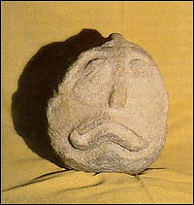
During IX-VIII millennium before our age the local population established a unique and long lasting culture in the Djerdap area. The period is named for the location of its peak, THE LEPENSKI VIR CULTURE. In this location two great cultural heritages were created: sacral architecture with monumental sculptures, which expressed a special vision of the world and the mastery of domestication of plants and animals, founding the new economy based on food production.
A millennium later, between 4500 and 3500 years before our age a large settlement of Danubean agriculturists developed the area of today's Belgrade at the sight of Vinca, a metropolis of one of the most glittering cultures of the European prehistory. The inhabitants of prehistoric Vinca and their fellow tribesman in Banat, Pomoravlje and Kosovo and Metohija had established a very specific culture during the earlier stone-age called VINCAN CULTURE which dominated all of middle and south-eastern Europe. Vinca and some other Neolite settlements in the vicinity of Vrsac (Potporanj), Kragujevac (Grivac, Divostin), Kosovska Mitrovica (Valac) and Pristina (Predionica) became big religious centres and focal points for art and had a crucial influence on the painting culture of all Neolite settlements of middle and south-eastern Europe. Hundreds of thousands of clay figures and ritual vases found in the mentioned settlements reveal not only the extraordinary imagination and artistic ability of their creators but also the development of myth and the rapid expansion of magic religious practices within the Vincan culture.
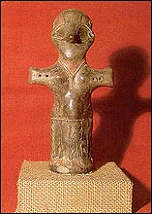
This special sacral world lived in the Balkan peninsula up to the time of the spreading of Christianity. Part of it is most probably embedded in the foundation of ancient European mythology i.e. old Greek myths about Demetra, Dionis and the divine blacksmith, Hefest.
VATIN CULTURE, created after the fall of Vincan Culture, was founded 1600 years before our age and is characterized by stone and bone carvings and the formation and decoration of clay dishes. The specific decorative style expressed on the items of the Vatin culture is found on the items discovered in the Kings Circle of tombs in Mikena originating from the middle XVI century before our age.
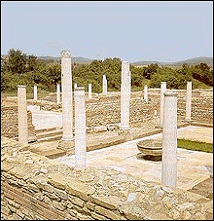
The territory of present day Serbia was under the ROMAN EMPIRE for six centuries. During that time the towns of Sirmium, Singidunum, Viminacium, Nais, Ulpiana developed and bridges and roads were built as well as a few imperial palaces and summer houses.
By the end of the III and in the first decades of the IV century at the time of Dioklecian, Galerian, Licinis and the Great Constantine's reign the magnificent architectonic ensembles were built- Romuliana (Gamzigrad near Zajecar), Mediana (Brzi Brod near Nis) and Justiniana Prima (Cesarean City near Lebane).
Construction activity began in all larger cities and especially in Sirmium (Sremskoj Mitrovici) which at the time had a large forum, an imperial palace with a hippodrome, luxurious baths, many palaces, a theatre and an amphitheatre. Many frescoes and sculptures have been discovered in this area.
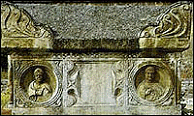
Handicraft was significantly developed during the reign of Constantine the Great. The imperial crafts of Nais (Nis) included silver dishes which were used as gifts for army commanders.
At the end of the VI and in the first decade of the VII century there was a fall in creativity. The increased pressure of the barbarians on the inhabitants of Panonian, Dakijan and Dardanian forced them to withdraw towards the southern part of the Balkan peninsula. The Danubian region was depopulated and during the second decade of the VII century, during the reign of the Czar Iraklije, all the territories of modern Serbia were conquered by the Avars and Slovenes.
 2 - SERBIAN ART FROM X TO XVII CENTURY 2 - SERBIAN ART FROM X TO XVII CENTURY |
 A. Architecture A. Architecture |
In the medium Balkan space predominantly inhabited by Serbs, church construction and engineering started to develop under the influence of the Byzantine establishments and their founders. The oldest pieces of Serbian art and architecture show that the Serbs accepted Byzantine art. During the X century many three nave basilicas whose ruins and traces are hidden by the church buildings of a later stage (See Section: Monasteries of Serbia).
 B. Painting B. Painting |
The frescoes preserved from the period before Nemanja supports the value of the church buildings. The mural paintings in PETROVA CHURCH from the 10th century are of great importance. The oldest layer was created immediately after the construction and covers the cupola tambour areas and upper areas beneath the cupola. In the tambour there are five scenes from Christ's life.
The appearance of Stefan Nemanja influenced both construction and painting in Serbia. The painting of all Nemanja's foundations was carefully planned. Frescoes of Nemanja's time marked the appearance of glittering art creations that became, in the following few centuries, a close part of the foundations of his descendants, church dignitaries and landowners.
A small painting inheritance from the areas across Sava and Danube from the 16th and 17th century (Krusedol, Serbian Kovin, Petkovica, Novo Hopovo, Orahovica) show a crossing of painting trends whose founders are in Sveta Gora, Italian-Crete art and local traditions.
The rebuilding of the Pec Patriarchate in 1557 is marked in the history of The Serbian Church Organization and in the Serb population under the Turks as an exceptional event and as a certain crossroad in its faith. In the development of art it had a far-reaching significance. This fruitful age can be divided into three stages: in the first stage, from 1557 to 1614, the most significant architectonic creations and the most harmonious paintings by style were created, whose artists belonged predominantly to the Pec art workshop. The second stage from 1614 to 1647 was marked by a renaissance of the painting activity and the third stage, from 1647 to 1690, is characterized by the activity of one painting workshop originating from northern Greece and of a few domestic painters.
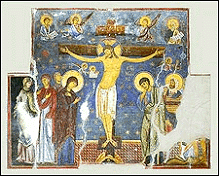
Studenica's frescoes from 1208 to 1209 formed the basis of the new style of art development in the 13th century. The merit for introduction of the manuscripts in Serbian language and the themes from Serbian history and literature belongs to Saint Sava who together with his brothers, Vukan and Stefan, brought the best of Constantinople's masons to decorate the foundation of their father's relics which were transferred from Hilendar and were already laying in the mausoleum.
The characteristics of the new style of the 13th century are illustrated in the large dimensions, simplicity and the width of the carving decoration, festive figurine positions and in the abstract type of saint. One of the most well-known of Studenica's frescos is a Crucifix on the west wall and has a characteristic azure blue background.
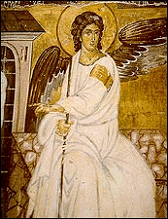
Milesevo painting, whose artists were most probably educated in some mosaic workshop in Constantinople, founded before 1228, expresses the best of the wall painting of that century. The Nemanjic portraits, the portraits of THE WHITE ANGEL from the fresco Mironosice on Christ's tomb, Madonna from annunciation are characterized by colour, shape and sound harmony.
The Resurrection composition in the cube of the Saint Apostles in the Pec Patriarchate as well as Studenica's and Zica's crucifixes express the highest artistic ideals of their age, the ideals of the Serbian spiritualists of the 13th century.
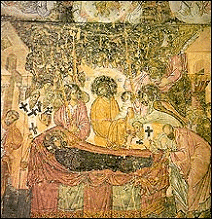
Sopocan painting, founded between 1263-1268, by painting esthetical and scientific values expresses a synthesis of the most progressive trends and has the most prominent place not only in Serbian but also in Byzantine and even in European art of the second half of the 13th century. The style of the altar and naves of the Sopocan Church of the Three Saint is based on the double traditions of the colourful style and Hellenistic shape. The best known Sopocan art, the Assumption of the Madonna, on the west wall incorporates all the best characteristics of the great artist who worked in naos.
In King Milutin's time, Serbian wall paintings developed together with those of Constantinople and Solun. The artists in Serbia, together with the royal painters, solved the same problems and took part in defining the characteristics of the new painting view, The Paleologist's Renaissance.
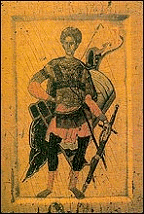
The development of Serbian icon painting can be traced back to the 12th century when the oldest creations exist and since the written testimonies appear in the biographies of the first Nemanjic's. In a valuable icon collection in Hilandar Monastery, a mosaic icon is separated by the appearance of the Madonna of Odigitrije, most probably from the beginning of the 13th century.
The desire to return to the Byzantine ideals by the end of 15th and beginning of the 16th century is noticed also in the Serbian icon painting of the time. The testimony of these are the three icons from the collection of the People's Museum and the Museum of the Arts in Belgrade: The Hana Miracle, The Saint Sava and The Saint Simeon and The Saint Dimitrije icon.
Among the few creations of the first half of the 16th century nine icons of the Krusedol Monastery are especially expressive, created between 1509 and 1512. The gifted artist has based his opinion on the living traditions of Serbian art whose expressions lasted for a long time here as well as on the ideals of Italian-Crete icon painting.
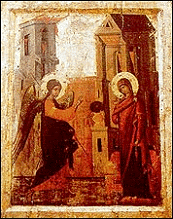
After the rebuilding of the Pec Patriarchate in 1557, icon painting activity became alive. In the Decani Treasure a few icons are kept whose authors show the will to restore the style of the 14th century. From that nucleus zoograph Longin arose, who painted a number of icon paintings in Decani, Pec, Velika Hoca, Pivi, Lomnica, Nikoljac and Crna Reka. One of the most significant of Longin's icons is the Saint King of Stefan Decanski painted in 1577.

In the middle of the 17th century Serbian icon painting reached a high level. Georgije Mitrofanovic introduced some shapes of Italian-Crete style into the Serbian icon painting. With its icons in Hilandar, Moraca, Zitomislic and Studenica this artist has surpassed the other painters of his time. From this period the name of zoograph Jovan is also important who has left a significant opus: the Madonna Mother With the Oracles, Christ With Apostoles and the Saint Jovan the Precursor (in Nikoljac near Bijelo Polje) painted in 1638-1639.
| During his stay in Hilendar from 1631-1632 Jovan painted icons of Saint Petka and Saint Dimitrije. One of his most significant creations is the icon painting of the Piva Monastery (1638-1639). It is important to mention the icon paintings of Mitrofan who painted icons and made icon paintings in Ovcar Kablar Monasteries and in churches around Cacak between 1602 and 1635 and Andrija Raicevic whose works are today in the Museum of the Serbian Orthodox Church.
 C. Folk architecture C. Folk architecture |
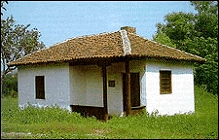
Folk architecture is simple and designed according to the needs and made of handy materials. It is not only functional but the decoration expresses the artistic skills of its masters.
In western Serbia the characteristic house is wooden with a farmstead. It is predominantly built of wood and most often it consists of two rooms: the house and the room. On the house there is a four sided roof covered with straw and usually has a decorative chimney.
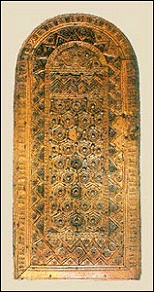
Moravka is a type of ground floor house consisting of two parts, with an obligatory porch. It is mostly present in the Moravia region of Serbia.
For the Panonic-Danubian regions the in-long or transversal house is characteristically made out of earth (firmly packed earth) or out of bricks in the street formation. These ground floor houses usually have more low rooms used for living and agricultural needs.
The city architecture south of Sava and Danube expressed shapes of the East Balkan construction heritage. The houses are floor houses with a number of sleeping rooms.
Houses in the whole region of Serbia are of the shape that with its form and decoration expresses aesthetic needs and the defined style. On the house and inside the house the porch arches are shaped, chimneys and the window.
There was colouring and painting of other parts of the house especially at the beginning of the 20th century. Special care was given to the decoration of the entrance gates and of fences.
 D. Carpet craft D. Carpet craft |
In Serbia there were a few carpet craft regions and centres with developed manufacture. They differ by the style, colours, ornaments and the way of their expression, decoration compositions. The common characteristic is that they are all double faced. The ornaments are usually styled geometric figures. The colours are dark and predominantly dark blue, brown, dark red and the natural wool and cotton colour.
PIROT was the most significant centre which significantly influenced other carpet craft regions. In ornaments and decoration composition of the old Pirot carpet craft there is a lot of eastern influence. For some motifs it is said that they are the heritage of the old Balkan Kavkaz art master pieces arising from the mutual praethnic fundaments and liaisons of other kinds for centuries.
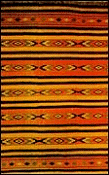
Many archaic elements are expressed on the carpet craft of Kosovo and Metohija. On Albanian cloth the old Mediterranean ornamentation is used while the coloring is black, dark gray and brown, violet and yellow colours.
The carpet craft of the Panonian region differs from other parts of Serbia by its older geometric and younger more figurative ornaments. The older ornaments show the link of Danubean region with the Preislamic East, and some connect it with the ornaments of the Roman mosaics. From the middle of the 19th century the civilizations of different items appear often with vegetable plant, zomorphic and anthropomorphic motifs made under the influence of the baroque, Ampir and Bydermayer.
 D. Embroidery and folk costume D. Embroidery and folk costume |
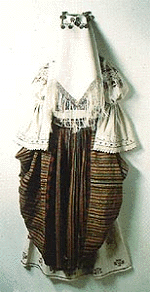
In folk embroidery, beside archaic heritage, especially in the mountain regions, much of the style was taken from the art of higher social layers and later eastern and middle European influence was incorporated.
In Vojvodina white and golden embroidery are predominant but there are multicoloured embroideries with bright colours also. For the women vests in the Moravian cultural region stylization of the big flowers of peony predominantly of the red and sometimes of the black colour are characteristic, while in the Dinaric regions there are more polychromes embroideries on the vests in which dark shades are predominant.
In the regions where cattle breeding is the major economy the women's vests are decorated on the bosoms and on the skirts by multicoloured wool embroideries.
 E. Art of recent times E. Art of recent times |
The 18th century is a century of rapid development of the city population. That process developed in the part of Serbian population under the reign of Austria. Thus most of the churches that were renewed by the beginning of the 18th century (Monasteries Krusedol and Velika Remeta) and of those that were built (Bodjani, Jazak I Sremska Kamenica) are marked by medieval poverty with elements of German baroque construction. And in that process the baroque details were most often added to the facade of the three leaf basement with a central cupola or a baroque bell was constructed beside the church. Representative monuments of that kind are The Church Of The Sisatovac Monastery (1758-1773) as well as The Synod Temple in Sremski Karlovci (1758-1772)
Contrary to the Serb architecture and graphics in Austria in which the influence of the foreign artists plays an important role, painting had and still is leaning on its own capacities. In Serbian art of the 18th century the late influence of baroque did not find fertile soil. In the work of Teodor Kracun, of Jakov Orfelin and of Teodor Ilic Cesljar, the best baroque painters in Serbia, one could speak about moderate and orthodox like conception of more formal than basic characteristics of baroque.
In the second half of the eighteenth century there is a wood carving renaissance. Good workshops and craftsmen, among which the Novi Sad family Markovic was a leader, founded the development of the applied arts.
The basic changes in the architecture of the 19th century took place after 1830 thanks to the rights derived from the hatiserif (Turkish law) of the same year. The constructors coming from the parts under Austria had a major role in these changes. That is why the buildings of that time are of classicists characteristics: Djumur Kana (Customs), The Synod Church and the house of Cvetko Rajovic (all three of them in Belgrade).
The end of the 19th century is marked by introduction of new ideas and more frequent presence of domestic architects: Alexandar Bugarski, Constantin A. Jovanovic, Svetozar Ivackovic and Jovan Ivcic.
The rise of architecture in Serbia started end of the fifties of this century. The new materials: iron, steal iron, concrete and glass with new ideas have marked the construction solutions. Today's architecture life in Serbia in theory and in practice is characterized by lot of varieties marked by post-modern ideas of art practice.
 F. Painting in the XIX and XX century F. Painting in the XIX and XX century |
Among the Serbian painters of the 19th century it is important to mention Arsenije Arsa Teodorovic, the author of the well known portrait of Dositej Obradovic, and Pavel Djurkovic, the author of the first portrait of Vuk Karadjic from 1816.
For the later decades between 1830 and 1860 one could say that they represent the renaissance of Bydermayer and Nazarene painting. Academic painters Jovan Isailovic the younger, Dimitrije Jovanovic and Pavle Simic have left heritage in the sacral painting based on the school of Vienna Nazarenes. On the other hand, Konstantin Danil, Nikola Aleksic and Jovan Popovic influence the forming of the style of the citizens based on the ideas from Bydermayer painting.
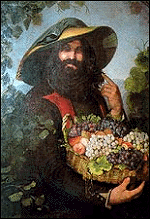
The honored place of the first lady painter in Serbia belongs to Catarina Ivanovic who stayed in Belgrade for short time, while she was attached to Stoni Beograd (Sekesfehervar, Hungary) by life and work.
The renaissance in the Serbian Principality starts in the fifth decade of the 19th century with the ideas of Dositej Obradovic and Vuk Karadjic. The rise of education and the establishment of the School of the Association of the Serbian Slovene Consciousness, Peoples Library and The Museum have supported Belgrade in becoming the capital of cultural life of the Serbian people.
The romantic style appears with the rebel painter and poet Djuro Jaksic, Stevan Todorovic, who started the first musical and sports activities, and Novak Radonic.
The realistic style in painting depended on the place of development or education of the artist and thus two directions existed: Kurbean composed of the works of Milos Tenkovic, Djordje Milovanovic and Djordje Krstic, as well as a direction defined by Vienna school popularized by famous Uros Predic and Paja Jovanovic.
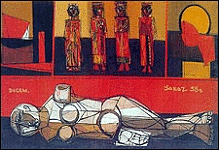
The expressionism of Nadezda Petrovic and impressionism of Malisa Glisic, Kosta Milicic, Milan Milovanovic and Borivoje Stevanovic represent the first decades of the fine arts in the 20th century. The appearance of this generation of fine art masters made it clear that Serbian culture and art turn towards Paris, as the new art metropolis. The protagonists of such art style were all directly attached to France. They were Jovan Bjelic, Sava Sumanovic, Ivan Radovic, Petar Dobrovic, Stojan Aralica, Veljko Stanojevic, Dusan Jankovic, Mile Milunovic, Marko Celebonovic, Mihail S. Petrovic, Petar Lubarda, Zora Petrovic. The 30s were a time when colour dominated over form. Among the expressionist colourists are Bjelic, Aralica, Ignjat Job I Milan Konjovic.
Among those using picturesque values of self in time based on the art solutions of the French painters were Bonar and Pissaro there are Ivan Tabacovic, Celebonovic, Gvozdenovic, Baruh, Ljubica Sokic. At the same time there are works of surrealist painters such as: Milena Pavlovic Barili, Radojica Zivanovic, or socially engaged painters like: Djordje Andrejevic Kun
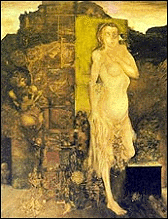
After World War II the development of the art schools and high schools already forming Universities was a support to the fine arts creativity in Serbia. Most of all many types of abstraction appeared, starting from the associative to expressionistic art (Bajic, Petrovic, Filipovic), but at the same time there are desires of some to express the link with the sight and tradition (Vozarevic, Vujaklija, Mica Popovic, Tomasevic). A group of medials and their spiritual mates Milan Popovic, Igor Vasiljev, Ljuba Popovic, Miodrag Djuric, Velickovic, Vidak, Sejka, Bradic, Ivanjicki, Vukovic, Milic Stankovic) use the surrealist elements. In the Serbian painting of the 60 ties of this century the ideas of Enformel were specially accepted (Protic, Pavlovic, Turinski, Todorovic, Popovic, Bozickovic).
By the end of 60s the painters accept numerous new ideas starting from pop art to hyperrealism (Blanusa, Otasevic, Cvetkovic, Damjanovski, Kalajic). The originality and the quality of the 70s is shown by the appearance of the artists who tried to combine the elements of realism with the ideas of conceptualism (Mojovic, Cvetkovic, Iljoski, Vasic, Damjanovski). The art of the 80s accepts and follows the variations of the poetics of the new picture of the new expressionism, new historicism, trans- or post-avantguard.
|

